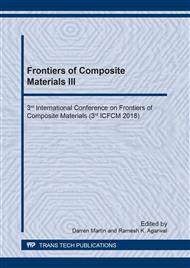p.3
p.9
p.15
p.21
p.27
p.33
p.39
p.45
Investigating the Effect of Nanoclay Loadings and Re-Processing on the Melting and Crystallization Behavior of PP/Clay Nanocomposites
Abstract:
In this study, PP/clay nanocomposites have been fabricated at different nanoclay loadings, i.e. 0, 5, 10, and 5 wt% for the 1st cycle and 2nd cycle (re-processing). The prepared nanocomposites were then characterized by a Differential Scanning Calorimetry (DSC) to investigate the effects of nanoclay loadings and re-processing on the melting and crystallization of the nanocomposites. The DSC results showed that the melting temperature, Tm was not significantly affected by the nanoclay loadings and re-processing. In the other hand, the degree of crystallinity, Xc of the nanocomposites was higher than that of neat PP, but only reached a maximum at nanoclay loading of 5 wt% (i.e. 51.2% for NC-5-I and 48.3% for NC-5-II). Thereafter, the Xc decreased at higher nanoclay loadings. There was no significant difference in Xc between 1st cycle and 2nd cycle. Additionally, in all nanocomposites samples for both cycles, there were two crystallization temperatures, i.e. Tc1 and Tc2. In the overall crystallization process, the Tc of nanocomposites increased by 11-12°C compared to that of neat PP. Whereas, the onset crystallization temperature, Toc also increased by approx. 13°C. Apparently, there was no significant effect of nanoclay loadings and re-processing on the Tc nd Toc of the nanocomposites.
Info:
Periodical:
Pages:
21-25
Citation:
Online since:
April 2019
Keywords:
Price:
Сopyright:
© 2019 Trans Tech Publications Ltd. All Rights Reserved
Share:
Citation:


